A Short Intro: Tropical Montane Forests (and why you should give a damn)
Hello Steemit friends! On this issue of my introduction series about the natural ecosystems of our planet, I will be introducing you to the montane ecosystem of the tropics. Montane ecosystems have fairly been conserved because they are hard to access. But with recent technological advances and the rise of "eco-tourism", montane ecosystems are increasingly being threatened. But what is a montane ecosystem? Read more to find out! :D
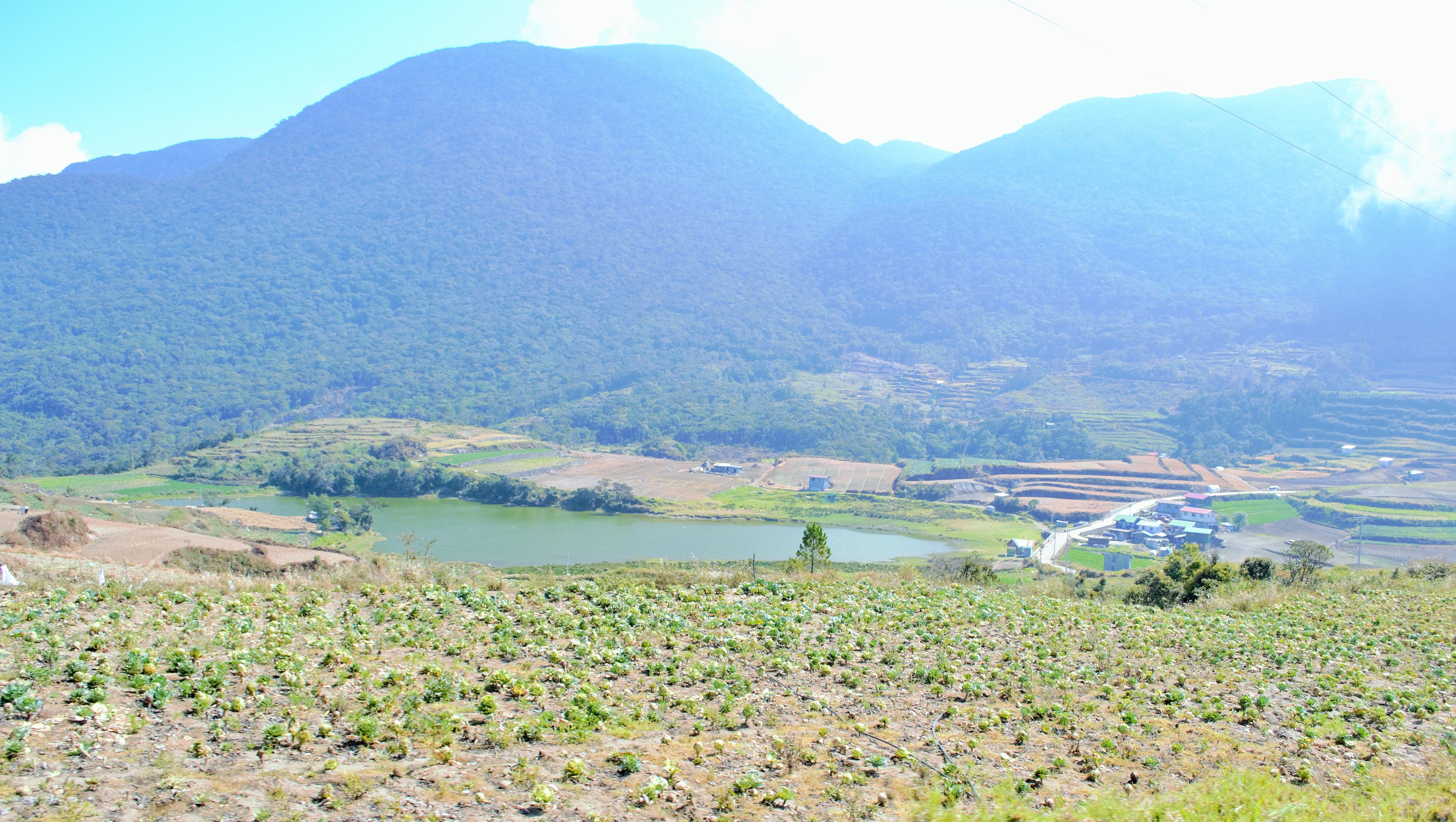
The forest-covered Mt. Tabayoc (photo taken by me^^).
On high altitudes, the prevailing conditions such as the lower atmospheric pressure, temperature, oxygen tensions while being subjected higher overall solar radiation, heat dissipation and wind exposure, make it relatively harder for any organism to live and propagate. As a result, specialist organisms adapted to these conditions tend to be more successful in montane ecosystems. And since the said environmental conditions tend to increase their effects as altitude increases, montane plant and animal communities form distinct zones as a response. Montane ecosystems have distinctive structure, species composition, and diversity as compared to their lowland counterparts (Osborne, 2012). Most montane ecosystems in the tropics tend to be forests, specifically mossy forests. Others are grasslands and “bonsai” forests.
Cold and wet

Fog is a daily feature in montane forests (photo taken by me^^).
Just like the rainforests, tropical montane forests have similar environmental conditions (except it is colder, a lot). In general, the top environmental conditions that have the highest influence in montane organisms are the temperature, relative humidity and precipitation. The diurnal (~again, day vs night) conditions changes are greater, and consequently have greater influence on the ecosystem as a whole. Temperature tends to be lower as altitude increases due to the following: 1) thinner atmosphere and less atmospheric pressure - which makes heat dissipation to occur at a faster rate, and 2) adiabatic cooling of warm air from low altitude meeting a mountain range which becomes cooler as the air expands and lose their heat energy. The adiabatic cooling lapse rate is normally 0.98°C/100m, but the moisture condensation moderate it to around 0.5-0.6°C/100m increase in altitude. Relative humidity tend to be lower overall (~as compared to lower altitude rainforests) due to thinner atmosphere, even if precipitation could occur daily in the form fog, snow, or rain (Osborne, 2012).
More numbers, less diverse
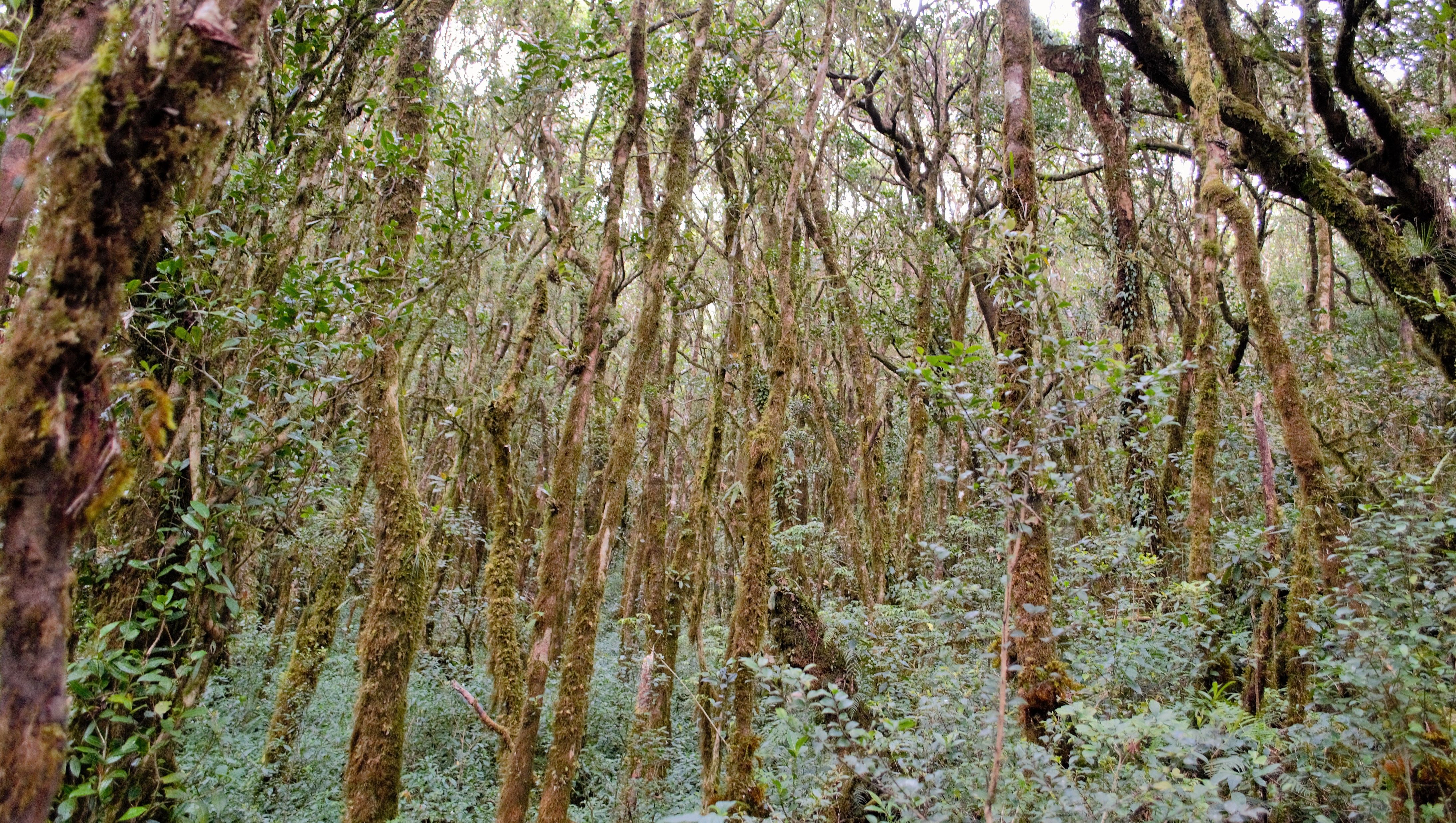
Mt. Tabayoc's Montane Rainforest (as shared in my Dean Visits 7 post).
The environmental conditions as the altitude increases generally favors C3 plants including mosses, ferns and epiphytes, and tend to limit plant growth rate and height in general (Ashton, 2003; Grubb, 1977; Whitmore, 1993). In terms of tree line, the canopy height (~height of tallest trees), diameter in breast height (~thickness of a tree’s main body at around 4.5 feet; DBH) and leaf area index (~size of leaves; LAI) tend to be lower as elevation increases. This allow for an increased tree density even though, as compared to tropical rainforests, montane forests tend to look more open and less dense. On the other hand, root biomass tend to increase with elevation, reflecting the greater need for water absorption (Leuschner and Moser, 2008; Osborne, 2012). However, the number of species in montane ecosystems generally tend to be lower in higher elevations (Jørgensen and León-Yánez, 1999). [Simply put, there are more number of trees in a given area because they are smaller, but there are lesser type of trees]
Plant adaptations
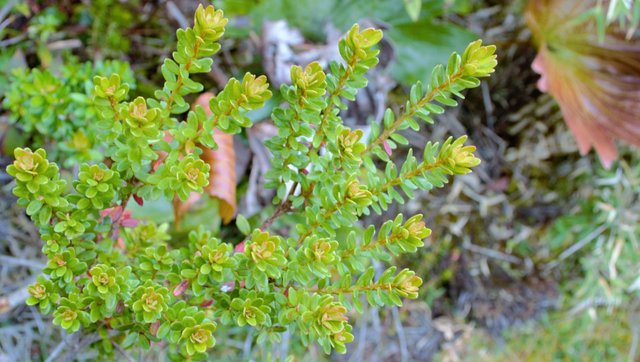
A plant in a "bonsai" forest (photo taken by me^^).
Plants have two general adaptations in montane ecosystems: freezing avoidance and freezing tolerance. Freezing avoidance is achieved by developing organs which allows for insulation and reduce heat loss of essential plant parts (Smith, 1974). It may also be achieved through accumulation of matter with high heat capacity within the plant, usually in the form of mucilaginous fluids (~just think of it as “bodily fluids”) with antifreeze capacity. Freezing tolerance, on the other hand, focuses more in preventing or reducing tissue damage due to freezing and can be achieved by utilizing uncharged organic compounds such as carbohydrates, amino acids and sucrose. These organic compounds, by forming hydrogen bonds in plant membranes, provide some protection by acting as cryoprotectant (~they prevent ice crystal damage on cells) (Hedberg, 1964; Coe, 1967; Krog et al., 1979; Young and Robe, 1986; Osborne, 2012).
Animal adaptations
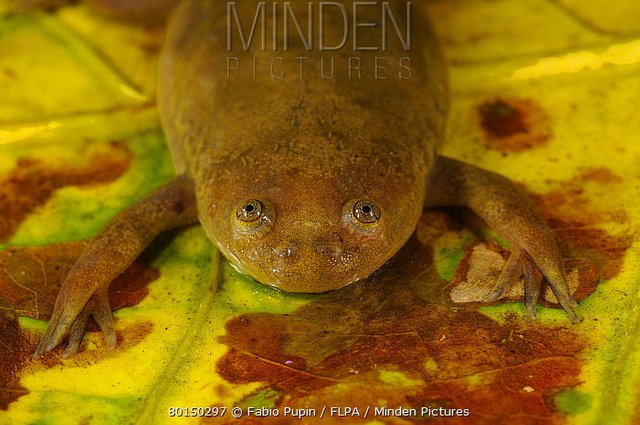
De Witte's Clawed Frog (Xenopus wittei), a montane forest animal. (Image source: https://www.mindenpictures.com/search/preview/de-wittes-clawed-frog-xenopus-wittei-adult-on-submerged-leaf-litter-in/0_80150297.html // ©Fabio Pupin / FLPA / Minden Pictures)
Montane animals generally take advantage of the more conducive microclimates the soil and even the plants provide. Most montane vertebrates generally burrow in the soil or underneath vegetation in order to escape the cold conditions, especially during the night. These burrows do not need to be deep since the frosts can only penetrate a few centimeters of the soil. Most invertebrates, adopt a cryptozoic life strategy; they never live being exposed to the atmosphere. Instead completely live off the soil or in litter. Animals that are not able to take advantage of such microclimate conditions generally have 2 adaptations: cold resisting and cold escaping. Cold resisting adaptation is achieved by developing body parts specifically to reduce the effect of cold weather in the body (e.g. development of dark and thick fur). While cold escaping basically involves migration to other areas once environmental conditions become harsh (e.g. buffalo, elephants and other large animals passing through from one forest patch to another) (Coe, 1969; Osborne, 2012).
Zonations and ecotones
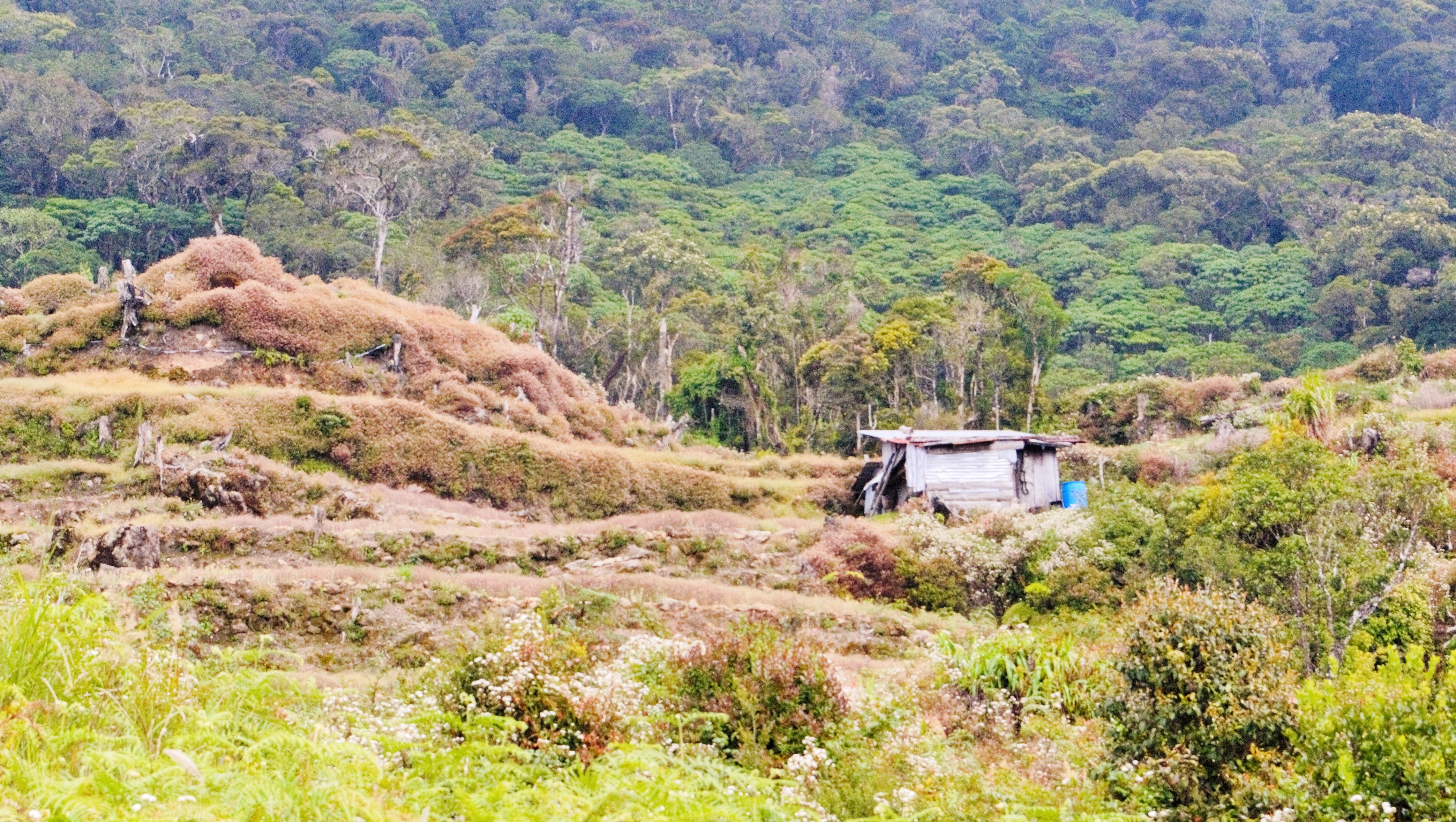
Mt. Tabayoc's lower grassland and lower montane rainforest ecotone (as shared in my Dean Visits 7 post).
Lowland rainforests have high species richness and species are well represented in terms of composition (with few exceptions), even though most are specialists species. But with increasing elevation, the composition of communities become more distinct and dominant species become more noticeable. Such changes in community composition are usually referred to as “altitudinal zonations”. Since each all communities can be identified through its ecotone boundaries, and all zonations tend to have a uniform, albeit unique, species composition, ecotones (~buffer zones) between zonations could also be observed. Basing on such zonations, montane forests can be categorized as follows: 1) lower montane forests which generally look like a rainforest but with noticeable decrease in canopy height and less diversity and 2) upper montane forests which is also called moss forest or cloud forest, reflecting a further change in species composition due to changes in environmental conditions (e.g. the lower rainforest vs the higher mossy forest of Mt. Tabayoc) (Osborne, 2012).
Another factor for zonation is the soil itself, specifically soil temperature. Though there been very limited studies about the subject matter, the coincidence between the optimum temperature for enzymes used by the plants for root protein synthesis, the temperature requirement for root growth and seed germination, and associated seasonal variations in ground temperature of 5-6°C could shed some light regarding the subject matter (Körner and Paulsen, 2004). Zonations may also be due to mountain size, the upper limits and size of zonations tend be higher in larger mountains. Perhaps aside from generally being warmer, known as the Massenerhebung effect, the increased resources and area for growth and reproduction that comes with greater mountain size would have a favorable effect (Grubb, 1977).
Hindered soil nutrient cycling
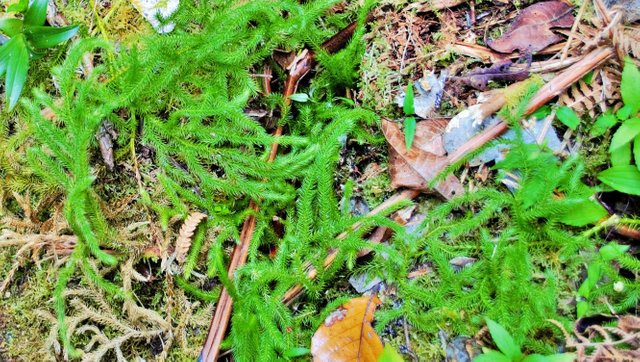
A crawling moss plant in Mt. Tabayoc's montane forest (photo taken by me^^).
The decomposers’ activity for nutrient cycling is usually hampered by low temperature in montane ecosystems. This is despite the soil having ample amount of organic matter deposits and relatively have enough moisture in order to support microbial activities. As a result, the soil layer tend to be shallow, skeletal, and rocky - especially in steep slopes. The soil contains high amount organic matter which is consequently readily deposited in peats and topographical depressions, and are likely to be washed away when it rains. All in all, primary production is kept high due to the high tree density, though at a decreasing rate as elevation increases (Rundel, 1980; Tieszen et al., 1979).
Prevailing anthropogenic issues
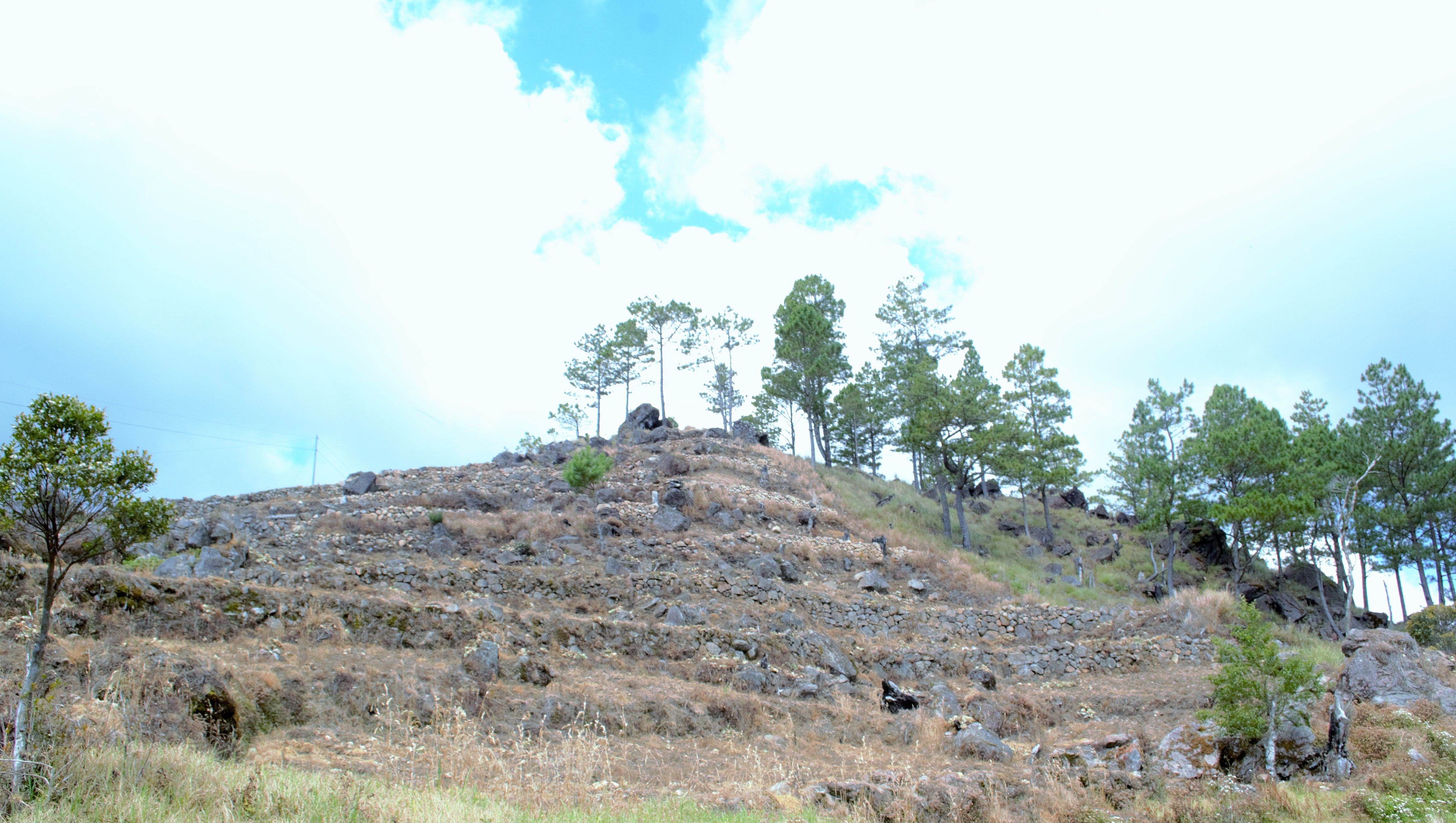
A cleared montane forest patch for agricultural production (photo taken by me^^).
As with tropical rainforests, human activities is the main culprit for the ecological changes and deterioration of montane ecosystems. Logging for timber, and change in land use for agriculture and mining are the most frequent activities that affect montane ecosystems. The lower montane forests are particularly at risk because its landscape is more accessible compared to the upper montane forests. Morris (2010) highlighted the main anthropogenic impacts on tropical forests’ biodiversity: 1) habitat destruction through deforestation which leads to ecosystem fragmentation, 2) species being driven to extinction due to over-exploitation, 3) threat to biodiversity by introduced invasive species, and 4) the potential lasting effects of climate change. The growing popularity of mountain climbing and trekking may help in the awareness in conservation. But on the other hand, such activities could cause disturbance in the delicate balance that montane ecosystems have (Barros et al., 2015).
References:
Ashton, P.S. (2003). Floristic zonation of tree communities on wet tropical mountains revisited. Perspectives in Plant Ecology, Evolution and Systematics 6: 87-104.
Barros, A., Monz, C., and Pickering, C. (2015). Is tourism damaging ecosystems in the Andes? Current knowledge and an agenda for future research. Ambio. 44(2): 82-98.
Coe, M.J. (1967). The ecology of the alpine zone of Mount Kenya. The Hague: Dr. W. Junk.
Coe, M.J. (1969). Microclimate and animal life in the equatorial mountains. Zoologica Africana 4: 101-128.
Grubb, P.J. (1977). Control of forest growth and distribution on wet tropical mountains: with specific reference to mineral nutrition. Annual Review of Ecology, Evolution and Systematics 8: 83-107.
Hedberg, O. (1964). Features of Afroalpine plant ecology. Acta Phytogeographica Suecica 49: 1-144.
Jørgensen, P. and León-Yánez, S. (1999). Results. In: Jørgensen, P. and León-Yánez, S. (eds.), Catalogue of the vascular plants in Ecuador, pp. 42-104. St. Louis: Missouri Botanical Garden Press.
Körner, C. and Paulsen, J. (2004). A world-wide study of high altitude treeline temperatures. Journal of Biogeography 31: 713-732.
Krog, J.O., Zachariassen, K.E., Larsen, B. and Smidsrod, O. (1979). Thermal buffering in Afro-alpine plants due to nucleating agent-induced water freezing. Nature 282: 300-301.
Leuschner, C. and Moser, G. (2008). Carbon allocation and productivity in tropical mountain forests. In: Gradstein, S.R., Homeier, J. and Gansert, D. (eds.), The tropical mountain forest – patterns and processes in a biodiversity hotspot, pp. 109-128. Biodiversity and Ecology Series 2. Göttingen: Universitätsverlag Göttingen.
Osborne, P.L. (2012). Tropical ecosystems and ecological concepts (2nd ed.) (pp. 78, 315-333). New
York: Cambridge University Press.
Morris, R.J. (2010). Anthropogenic impacts on tropical forest biodiversity: a network structure and ecosystem functioning perspective. Philosophical Translation of the Royal Society B 365: 3709-3718.
Rundel, P.W. (1980). The ecological distribution of C4 and C3 grasses in the Hawaiian Islands. Oecologia 45: 354-359.
Smith, A.P. (1974). Bud temperature in relation to nyctinastic leaf movement in an Andean giant rosette plant. Biotropica 6: 263-266.
Tieszen, L.L., Senyimba, M.M., Imbamba, S.K. and Troughton, J.H. (1979). The distribution of C3 and C4 grasses and carbon discrimination along altitudinal and moisture gradients in Kenya. Oecologia 37: 337-350.
Whitmore, T.C. (1993). An introduction to tropical rain forests. Oxford: Clarendon Press.
Young, T.P. and Robe, S.V.O. (1986). Microenvironmental role of a secreted aqueous solution in the afro-alpine plant Lobelia keniensis. Biotropica 18: 267-269.
Learn more about other ecosystems:


Nice post. Liked it:) This whale is from Norway, which has a lot of montane ecosystems, with a diverse range of animals, e.g. grouse, reindeer, artic fox (threatened) and wolverine (a real trickster).
My interest is piqued @whalereward! :) Would love to visit and observe some of Norway's montane ecosystems if I would get the chance. Sad to know about the arctic fox being on the threatened status.
Resteemed to over 5400 followers and 100% upvoted. Thank you for using my service!
Send 0.100 Steem or 0.100 Steem Dollar and the URL in the memo to use the bot.
Read here how the bot from Berlin works.
@resteem.bot
Thanks! :>
Another wonderful post on Ecosystem , now on Montane forests ecosystem. While was in college, we had to read a little about ecosystem. After that no touch with it. Your post is really elaborate and well described. Learning a lot.
Glad to share the knowledge @hafiz34.^^ I also enjoy learning from your medical posts.
Wow great post. burrowing into the soil to stay warm is a really rough way to survive. Thank God for adaptation.Good work
Thanks @georgechukwu!^^ But on another perspective, it shows how resourceful animals are. But the adaptation of desert animals is even more extreme.
Very true, they sure are really resourceful. and we humans can learn more from these animals, learning to make the maximum of what we have available
nice photos :-) It looks like a great place visit and now I give a damn about it! thanks
Thank you for your kind words @leap8. There's nothing wrong in visiting as long as we practice responsible tourism. :D
@eileenbeach has voted on behalf of @minnowpond. If you would like to recieve upvotes from minnowponds team on all your posts, simply FOLLOW @minnowpond.
Thank you @eileenbeach! :)
@cryptohustlin has voted on behalf of @minnowpond. If you would like to recieve upvotes from minnowponds team on all your posts, simply FOLLOW @minnowpond.
Thanks @cryptohustlin! :)
@royrodgers has voted on behalf of @minnowpond. If you would like to recieve upvotes from minnowponds team on all your posts, simply FOLLOW @minnowpond.
Thanks @royrodgers! :)
As a follower of @followforupvotes this post has been randomly selected and upvoted! Enjoy your upvote and have a great day!
Thanks! :>
@originalworks
The @OriginalWorks bot has determined this post by @dean101 to be original material and upvoted it!
To call @OriginalWorks, simply reply to any post with @originalworks or !originalworks in your message!
To enter this post into the daily RESTEEM contest, upvote this comment! The user with the most upvotes on their @OriginalWorks comment will win!
For more information, Click Here! || Click here to participate in the @OriginalWorks sponsored writing contest(125 SBD in prizes)!!!
Special thanks to @reggaemuffin for being a supporter! Vote him as a witness to help make Steemit a better place!